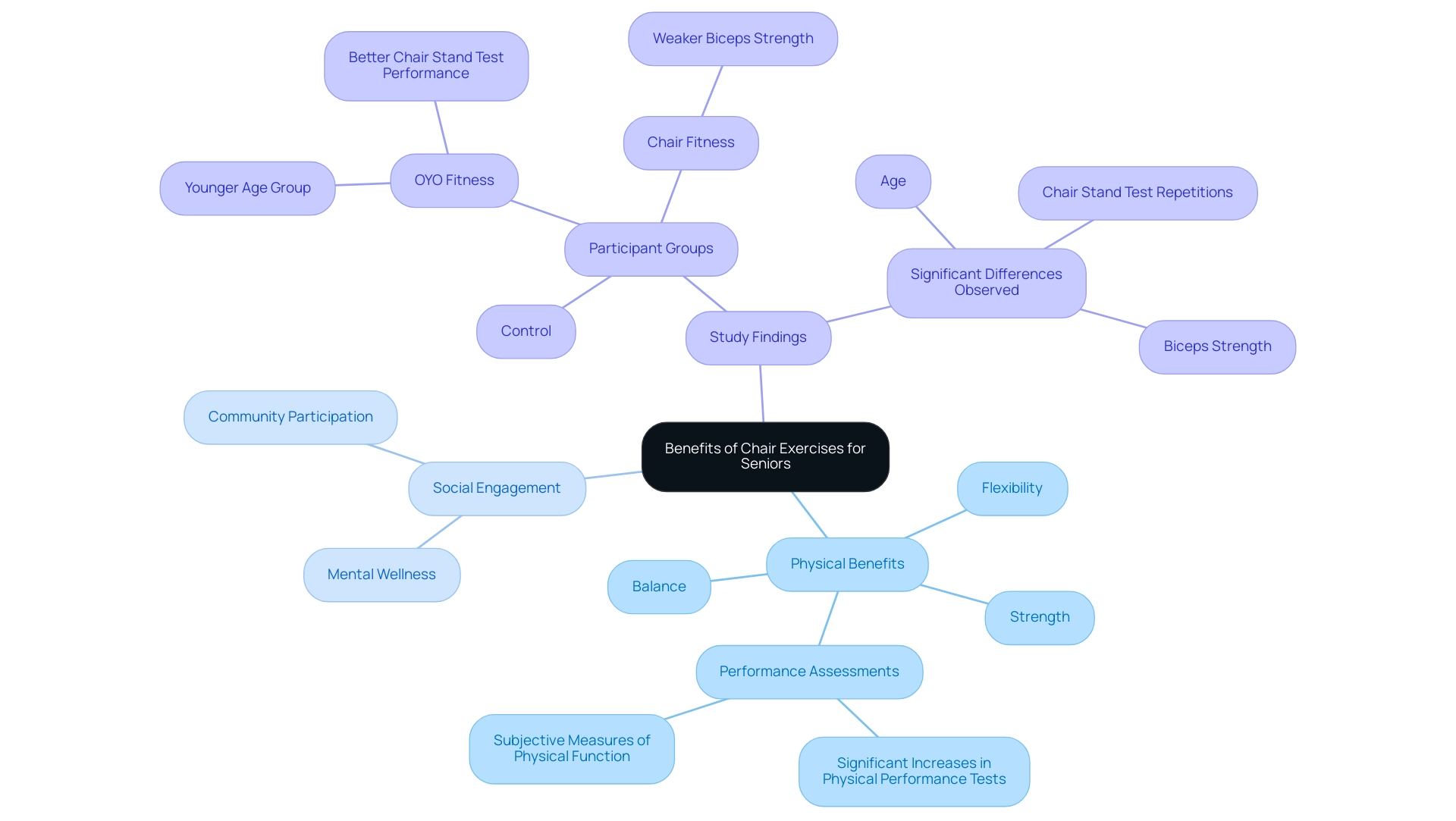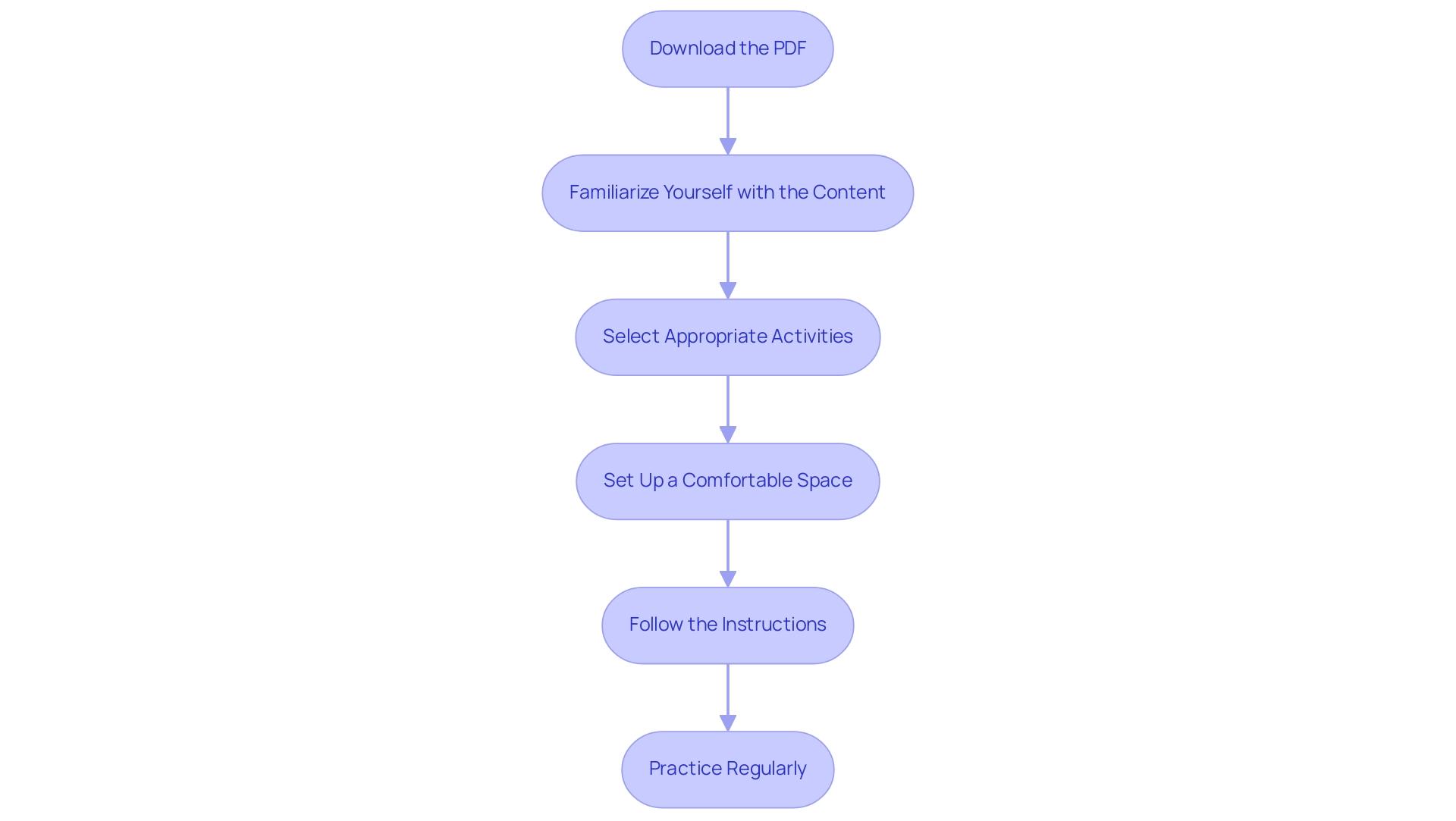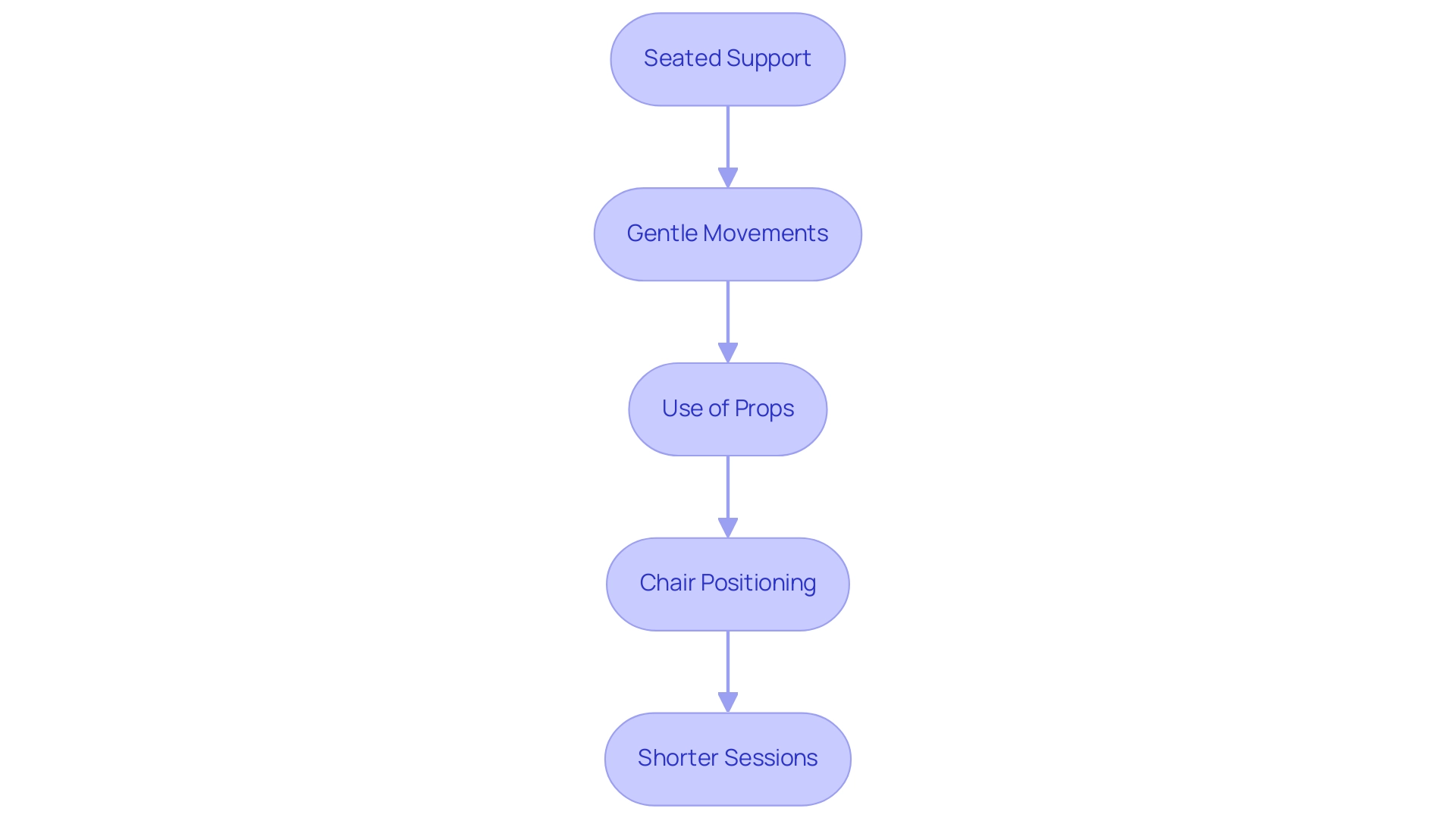Overview
Chair exercises are vital for seniors as they enhance strength, flexibility, and balance, which are crucial for maintaining independence and improving quality of life. The article supports this by detailing studies that show significant health improvements from regular chair activities, alongside the added benefits of social engagement and mental wellness, particularly important for older adults facing mobility challenges.
Introduction
As the population ages, maintaining physical health becomes increasingly vital for seniors. Chair exercises emerge as a practical solution, tailored to address the unique challenges faced by older adults. These low-impact activities not only enhance strength, flexibility, and balance but also foster social connections, contributing to overall well-being. Recent studies have highlighted the significant improvements in physical performance and mental health associated with regular participation in chair-based workouts.
With a structured approach, seniors can safely engage in these exercises, ensuring they remain active and independent while enjoying a higher quality of life.
The Importance of Chair Exercises for Seniors
Chair routines, often detailed in a chair exercises PDF, are specifically created to address the unique bodily limitations encountered by seniors, allowing them to safely and effectively participate in movement. A recent study uncovered that engaging in chair-based activities over a duration of 26 weeks resulted in notable enhancements in various performance assessments, emphasizing the significance of these actions. Regular involvement in such activities is crucial, as they enhance flexibility, strength, and balance—all vital for maintaining independence and improving the quality of life among older adults.
Significantly, subjective assessments of bodily function, which evaluate personal perceptions of their capabilities, were also employed in the studies, emphasizing the diverse experiences and results among participants.
Furthermore, the social engagement encouraged through group-based activities greatly enhances mental wellness, establishing them as a vital aspect of a senior’s fitness routine. Alana Biggers, M.D., emphasizes that returning to physical activity should commence at home with light tasks, stressing the importance of hydration and being attuned to one’s own body. This guidance is especially pertinent given the increasing amount of evidence supporting straightforward, seat-based activities like chair exercises PDF, particularly in light of the harmful impacts of inactivity noted during the COVID-19 pandemic.
As demonstrated in a study with 48 participants categorized into OYO Fitness, Seat Fitness, and Control groups, significant differences in fitness levels were clear, highlighting the diverse abilities and reactions to seat-based activities. The Fitness group displayed reduced biceps strength and performance in sitting stand tests compared to the Control group, highlighting the essential need for organized physical activity programs to improve health outcomes in seniors. Overall, chair exercises PDF not only provide significant health advantages but also foster social connections, thereby enhancing the lives of the elderly and supporting their general well-being, especially for those dealing with conditions like Type 2 Diabetes.
How to Effectively Use Chair Exercises PDF: A Step-by-Step Guide
To maximize the benefits of chair exercises PDF, follow these steps:
- Download the PDF: Access the provided link to download the document onto your device.
- Familiarize Yourself with the Content: Review the table of contents to gain insight into the variety of activities available.
- Select Appropriate Activities: Choose activities that align with your fitness level and accommodate any physical limitations you may have.
- Set Up a Comfortable Space: Identify a sturdy chair in a quiet area, ensuring it is free from distractions.
- Follow the Instructions: Each task detailed in the chair exercises PDF comes with clear guidelines; read these carefully prior to commencing.
- Practice Regularly: Incorporate these activities into your daily routine to achieve optimal results.
It’s important to note that the proportion of adults reporting no leisure-time exercise decreased from 40.4% in 1994 to 33.9% in 2013, highlighting a growing awareness of the significance of exercise. Successful measures for enhancing movement among older individuals consist of training programs that emphasize muscle strengthening and aerobic exercises. Furthermore, community supports for walking, as illustrated in the case study ‘Step It Up!’ highlight the importance of including seated workouts in a wider plan for improving movement among older adults.
By following this structured approach, you can enhance your activity effectively, ultimately contributing to better health outcomes.
Recommended Chair Exercises for Seniors: Examples and Variations
The subsequent seated activities are suggested for older adults, intended to improve strength, balance, and overall physical well-being:
- Seated Marching: While seated, lift one knee at a time in a marching motion. This activity is essential for enhancing leg strength and coordination. A 2020 study emphasized that chair activities, as detailed in a chair exercises pdf, led to significant positive health changes for older women, underscoring the importance of such pursuits.
- Arm Raises: Raise both arms overhead while seated, then lower them back to your sides. This movement strengthens shoulder muscles, contributing to better upper body strength and mobility.
- Seated Leg Extensions: Extend one leg straight out while seated, hold for a few seconds, and then lower it. This activity enhances knee strength and stability, which is crucial for preventing falls—a significant concern among elderly individuals.
- Torso Twists: Sit upright and gently twist your torso to one side, then the other. This activity enhances spinal flexibility, which is essential for preserving mobility as one ages. Variations of these activities may include the use of light weights or resistance bands to increase the challenge.
As noted by Paul B Tchounwou, the integration of diverse physical activities can significantly benefit older adults. Furthermore, findings from Hawley H et al. regarding fitness instructor attitudes toward older adults suggest that instructors who are positively inclined towards seniors can enhance the effectiveness of these activities. Integrating chair exercises pdf into a consistent regimen can offer various advantages, such as enhanced balance, strength, and overall bodily function.
It is important for participants to provide active feedback on each session, as demonstrated in the evaluation of community-based physical activity programs, which achieved a 100% agreement in Round 3 regarding the effectiveness and enjoyment of the activities. Additionally, subjective measures of physical function, such as the falls efficacy scale, can help in assessing the improvements experienced by seniors participating in seated activities. By actively engaging in these activities, seniors can promote their autonomy and enhance their quality of life.
Adapting Chair Exercises for Limited Mobility
For seniors facing restricted mobility, especially those with an average age of 77.5 years (Yao, 2019), the following modifications can improve safety and effectiveness during chair-based activities:
- Seated Support: Select a robust seat with armrests to offer extra assistance while carrying out activities.
- Gentle Movements: Emphasize slow, controlled movements to minimize the risk of strain or injury.
- Use of Props: Introduce resistance bands or light weights that are manageable and safe for use during workouts.
- Chair Positioning: Ensure that the chair is securely positioned against a wall when necessary, to bolster stability.
- Shorter Sessions: Initiate workout routines with shorter durations, gradually increasing the time as comfort and endurance improve.
These adaptations are essential, as chair exercises pdf demonstrate the benefits of chair-based activities for older adults. Always consult with a healthcare provider before starting any new fitness program.
As noted in a recent review,
In this voyage of vitality, safety isn’t the killjoy – it’s the wind in your sails, propelling you toward horizons of health you thought long past.
Furthermore, a methodological quality assessment of included studies revealed that 17 studies had a low risk of bias, indicating a generally high quality of evidence supporting the effectiveness of chair-based activity interventions. This perspective emphasizes the importance of safe adaptations in fostering an active lifestyle.
Health Benefits of Chair Exercises for Seniors
Chair activities, as detailed in the chair exercises pdf, offer a multitude of health advantages for seniors, rendering them an invaluable element of a balanced fitness regimen. Key advantages include:
- Improved Strength: Engaging in regular chair routines has been shown to significantly enhance muscle strength, which is essential for performing daily activities. A study involving 85 participants, with an average age of 77.52 years and 1.46 chronic diseases, highlighted the importance of maintaining strength as we age. Significantly, participants in the comparison group attained an average of 54.7 counts (SD: 20.1) in the 2-min step test, highlighting the physical enhancements linked to regular activity.
- Enhanced Flexibility: These activities promote joint flexibility, helping to reduce stiffness and improve overall mobility. This is particularly beneficial for seniors who may experience limitations due to age-related changes.
- Improved Stability: Strengthening core muscles through seated movements is essential for preventing falls—a significant issue among the elderly. The outcomes from recent intervention studies show a significant enhancement in daily living tasks, as the intervention group indicated a rise in their functional scores post-exercise.
- Mental Health Advantages: Participating in movement through seated workouts is associated with enhanced mood and cognitive abilities. Regular participation can help reduce the risks of depression and anxiety, fostering a better quality of life.
- Social Interaction: Group physical activity sessions not only offer physical advantages but also promote community and social connections. This aspect is vital for combating feelings of isolation that can affect mental health among seniors.
Additionally, the seated row movement, which focuses on upper back muscles, illustrates how such practices can improve posture and overall strength. Participants drawing their elbows back while seated have reported significant improvements in these areas. According to Manoj Sharma, an academic editor, “This study aims to investigate the effectiveness of yoga therapy on enhancing functional status and daily life performance scores in older female adults with knee osteoarthritis residing in the community.”
This demonstrates the wider effect of seated workouts on functional status and daily life tasks among older adults. Collectively, the health benefits of chair exercises pdf underscore their importance in promoting well-being in senior populations.
Conclusion
Chair exercises are an essential component of maintaining health and independence for seniors. These tailored physical activities address the unique challenges faced by older adults, enhancing strength, flexibility, and balance while reducing the risk of falls. Regular participation in chair exercises not only leads to significant improvements in physical performance but also fosters mental well-being through social interaction and community engagement.
The structured approach to chair exercises allows seniors to safely integrate physical activity into their daily routines, accommodating varying levels of mobility. By incorporating specific exercises such as:
- Seated marching
- Arm raises
- Torso twists
seniors can experience a multitude of benefits, including improved strength, enhanced flexibility, and better balance. Adaptations for those with limited mobility further ensure that all seniors can participate effectively and safely.
In summary, chair exercises represent a practical and impactful solution for enhancing the quality of life among older adults. By prioritizing these activities, seniors can enjoy greater autonomy, improved health outcomes, and enriched social connections, ultimately leading to a more fulfilling and active lifestyle. Embracing chair exercises is not just about physical fitness; it is about fostering a sense of community and well-being that is vital for aging gracefully and healthily.
Frequently Asked Questions
What are chair routines and who are they designed for?
Chair routines are exercises specifically created to address the unique bodily limitations encountered by seniors, allowing them to safely and effectively participate in movement.
What benefits do chair-based activities provide for seniors?
Engaging in chair-based activities enhances flexibility, strength, and balance, which are vital for maintaining independence and improving the quality of life among older adults.
How long should one engage in chair exercises to see improvements?
A recent study indicated that participating in chair-based activities over a duration of 26 weeks resulted in notable enhancements in various performance assessments.
What role do subjective assessments play in evaluating the effectiveness of chair exercises?
Subjective assessments evaluate personal perceptions of bodily function, emphasizing the diverse experiences and results among participants in the studies.
How does social engagement factor into chair exercises?
Group-based activities encourage social engagement, which greatly enhances mental wellness and is considered a vital aspect of a senior’s fitness routine.
What initial steps should seniors take when returning to physical activity?
Seniors should start at home with light tasks, prioritize hydration, and listen to their own bodies, as emphasized by Alana Biggers, M.D.
What findings were reported in the study involving 48 participants and chair exercises?
The study showed significant differences in fitness levels among groups, with the Fitness group displaying reduced biceps strength and performance in sitting stand tests compared to the Control group.
What health advantages do chair exercises offer?
Chair exercises provide significant health benefits and foster social connections, enhancing the lives of the elderly and supporting their general well-being, especially for those with conditions like Type 2 Diabetes.
How can one maximize the benefits of chair exercises?
To maximize benefits, individuals should download the exercises PDF, familiarize themselves with the content, select appropriate activities, set up a comfortable space, follow the instructions, and practice regularly.
What trend has been observed regarding leisure-time exercise among adults?
The proportion of adults reporting no leisure-time exercise decreased from 40.4% in 1994 to 33.9% in 2013, indicating a growing awareness of the significance of exercise among older individuals.




